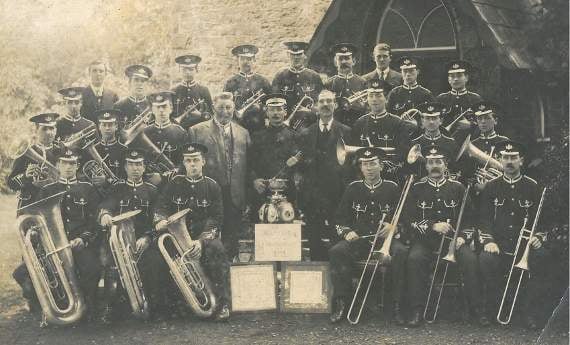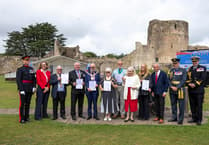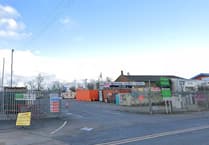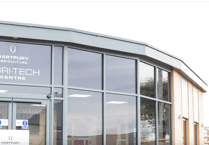THE long history of brass bands in the Forest was celebrated at the Dean Heritage Centre over the weekend and it is hoped that Review readers can help fill in some gaps in that story.
The centre at Soudley has two pictures – reproduced here – with one showing the Cinderford Band after winning a competition at Oaklands in 1914.
The other, showing a much depleted band collecting for local hospitals, was taken two years later when most of the younger men had left to fight in the First World War.
The Forest Musical Landscape project – which is part of the wider Foresters’ Forest celebration of the history and culture of the Dean – would like to know the names of the players.
If you can help, contact Sharon Stratford on (01594) 564920 or the Dean Heritage Centre on (01594) 822170.
The band was already well-established at that time, having been formed in 1879.
Brass bands had begun to emerge in the middle of the 19th century and were particularly associated with the mining and textile districts of the country with their growth being aided by the mass manufacture of instruments.
The earliest bands in the Dean were formed in places such as Mitcheldean and Littledean and were ‘drum and fife’ bands associated with the militia.
The growth of brass bands was encouraged by industrialists, who saw them as means of self-improvement for their workforce and offering an alternative to the pub.
The first brass band in Britain was started at Merthyr by an industrialist family well-known in the Forest – the Crawshays, who built Blaisdon Hall.
The first brass bands in the Forest were associated wth the Cinderford Ironworks owned by Henry Crawshay.
They went under various names such as the Crawshay Band, the Ironworks Band, the Wireworks Band and the Vale Band.
There was also the Robin Hood Band which was associated with the iron mine.
Of course, there are bands across the Forest which can trace their history back to these pioneering musicians.
The Lydbrook Silver Band emerged from the Trafalgar Brass Band while the Speedwell Colliery Band amalgamated with the Berry Hill Temperance Band to become Berry Hill Silver Band.
There was a band in Yorkley as early as 1860 and three years later there was one in Parkend.
The Princess Royal Colliery Band was renamed Bream Silver Band in 1912.
More than a century on, the current band performed for visitors over the weekend and there was a fascinating display of artefacts from the centre’s collection of brass band memorabilia.
There was also a rare outing to the Dean of the UK’s top trophy for brass bands which was brought to the Forest with the help of the Four Bars Rest brass banding website.
The event was opened by Jan Royall, Baroness Royall of Blaisdon, who praised the contribution of brass bands to the life of the Forest over the years and who promised to become a ‘champion’ for the art form.
She said: “In the Forest we have a vibrant working class history and brass bands bring together our social and industrial heritage which this museum so clearly illustrates.
“With the Industrial Revolution, mining here became intense and in the 19th and 20th century it had an enormous impact on our economy, on our community but also on our culture.
“Industrialisation meant that musical instruments became more readily available and I have no doubt that the bosses liked and encouraged brass bands because they wanted their workers to flourish when they weren’t down the pit but they also wanted to keep them down a bit and it was good PR for the collieries.
“But for the workers they were a fantastic expression of solidarity as well as a celebration of their own working class culture.
“They were and they still are a matter of civic pride for our communities.
“Brass bands enabled men of all ages to come together to create a sound that was beautiful, uplifting and inspiring.
“It also gave men dignity and a sense of worth and enabled their families to experience a joy and pride in their menfolk – life was a struggle in mining communities but there was fantastic cameraderie and a thirst for culture.
“Music was a form of liberation from the grinding hardships and demands of the owners and in the Forest we have a proud history of activism of fighting against authority, and brass bands were a means of demonstrating the strength and unity of our community.
“The bosses might have owned our bodies but they did not own our souls.
“Society has changed and the bands have changed but the splendour of the music has not. The pits have gone and we’ve lived through years of deindustrialisation but our communities are strong and so are our brass bands.
“A few weeks ago I was at Proms in the Park at Speech House and we had fantastic music from the Lydbrook Band on that occasion but I know for centuries brass bands have gathered on the Speech House field to celebrate brass band culture.
“We now have women in bands which is great and lots of youngsters, both female and male – in Cinderford you are doing a great job, with the young people’s academy encouraging youngsters to carry on our tradition.
“What’s important is that when young people take up an instrument it is great for their confidence and they do better at school and it is good for social mobility.”
As well as the performances and displays there was also the opportunity for visitors to try out an instrument.
Baroness Royall added: “Today, I heard a girl utter a noise on a cornet for the first time – how good is that?”
She said while brass bands still play an important cultural role in the community, funding could be a headache.
“Of the money from the Arts Council that goes to music, about 62 per cent goes to opera. I’ve got nothing against opera but less than one per cent goes to brass bands.
“ I didn’t realise that but that is something I’m going to start campaigning about because brass bands are part of our working class culture and if we lose that culture then our community and our country is going to be diminished.
“So I am going to be one of your champions now – I know nothing about brass band music but I love it and I love the way it gets you, there, in the stomach with the emotions.”
The band played a wide variety of music from traditional brass band tunes to musicals, the classics and pop and rock including arrangements of songs by Michael Jackson and Coldplay.
The first tune of the event was a march composed especially for the band by Tom (TJ) Parker written when he visited the Forest after the Second World War and, appropriately entitled ‘Cinderford’.
There were also a number of solos including a version of ‘Bring Him Home’ from Les Miserables by Andy James on soprano cornet and an interpretation of Katie Melua’s ‘Closest Thing to Crazy’ by principal horn Barry Watkins.
As well as the brass band, visitors were also entertained with a comic play by the Forest of Dean mummers.
-----------
Clive’s guide to the band
WHILE many people enjoy brass band music, fewer understand the components that make up the distinctive sound.
Clive Lewis, who conducted the band gave a handy introduction to the instruments, although the band was not at full strength because of members’ holidays and other commitments.
The giants of the band are the B flat basses and the E flat basses “which are smaller but still something.”
The euphoniums are the “captains of the bottom end of the band, giving a lovely, warm, round sound.”
Then there is the sole baritone and the tenor and bass trombones.
Mr Lewis said: “The bass trombone makes a lovely trio with the tenor trombones and puts some colour into the top of the bass line.”
The tenor horns are always called ladies, even if it is a man sat behind them.
In the middle is the flugelhorn which “sometimes floats in with the tenor horns and sometimes with the cornets — anything anyone else doesn’t want, he gets.”
The high notes are provided by the cornets, particularly the soprano and Andy James gave an impressive 17-second long note on his.
The band is completed by the percussion section which includes various drums and instruments such as the tubular bells.
The high notes are provided by the cornets, particularly the soprano and Andy James gave an impressive 17-second long note on his.
The band is completed by the percussion section which includes various drums and instruments such as the tubular bells.
--------
Long-playing history
AMONG the many musical artefacts on display at the Dean Heritage Centre was an item that may still be in one or two record collections around the Forest.
Back in December 1974, when the likes of David Essex and The Wombles were in the charts, pupils of Whitecross School in Lydney also made a record.
The LP features music and readings from a Christmas concert recorded at the school on Wednesday, December 18 and later made into an LP from an original tape at the Sound News Studios in London.
On the back of the sleeve are the names of dozens of pupils who took part in the concert and several of them are still playing with local brass bands.
Among them was Ruth Purvis – now Davies – who is secretary of Cinderford Band and one of its cornet players.
She said: “I don’t know how it came about but we had some very good music teachers and they were keen to have an orchestra and brass band.
“There were a lot of children going to different brass bands and so they formed a school band.
“Over the next four or five years we played together and we went on tour to Yorkshire. I have happy memories of that time.”
Mrs Davies first joined Bream Band and then moved to Cinderford where she recalls recording an edition of the popular 1980s Sunday night show ‘Highway’ which was filmed at the Dean Heritage Centre.
She said: “We did a recording here with Harry Secombe – it was December and the ducks were sliding onto the water because it was frozen.





Comments
This article has no comments yet. Be the first to leave a comment.